| Author |
Message |
|
Christian Böhling
Industry Professional
|
 Posted: Tue 02 Feb, 2010 2:21 pm Post subject: Posted: Tue 02 Feb, 2010 2:21 pm Post subject: |
 |
|
| Peter Johnsson wrote: |
EDIT: looking at the pics I posted I see it is hard to make out the octagonal section. You mostly only see a faint midrib. This is perhaps a reason why so many roman swords are described as having a diamond section? A little rust, and the details are easily lost.
|
I add some pics I made in our special exhibition hopefully better show what Peter means with octagonal shape... It was the same detail, I tried hundred times to catch on camera with that bad light from below 
These blades are from Illerup -- same date, same shape....same army? (possibly the equipment from the same army were brought from the same battle to different places to be offered, or the same army attacked different places and was defeated everywhere...)
Thanks Myles! You are one of those for whom this thread should be dedicated, cause what would we do, if no one would be interested in exept us two or three lunatics 
 Attachment: 110.48 KB Attachment: 110.48 KB

 Attachment: 98.16 KB Attachment: 98.16 KB
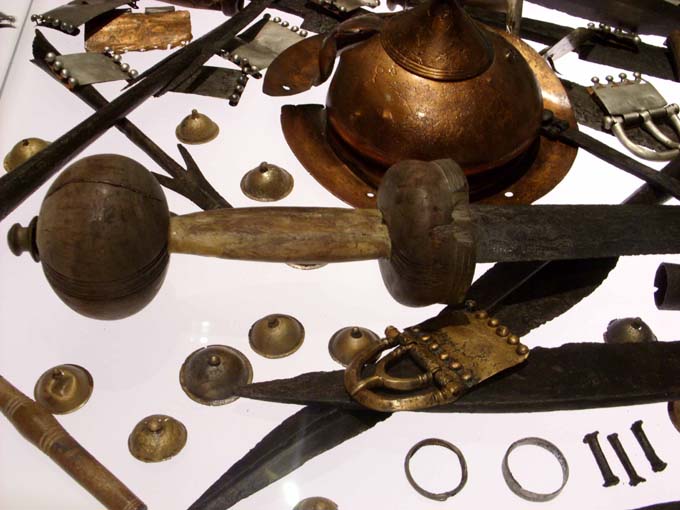
 Attachment: 96.77 KB Attachment: 96.77 KB

 Attachment: 100.36 KB Attachment: 100.36 KB
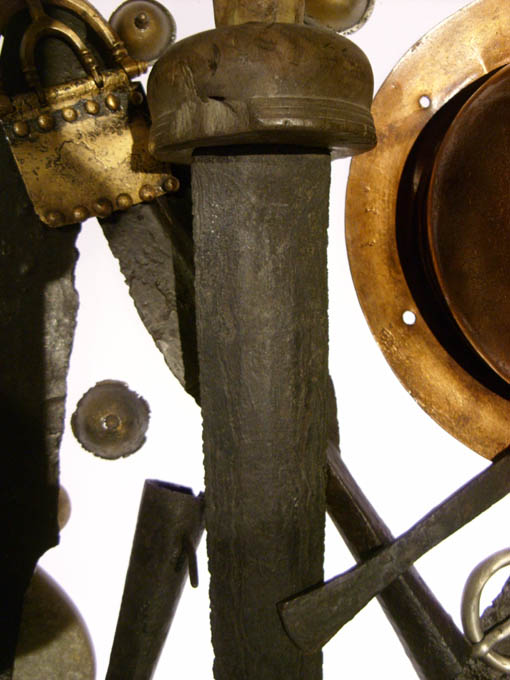
www.archaeoschmiede.de
www.eisenzeithaus.de
|
|
   |
 |
|
Christian Böhling
Industry Professional
|
 Posted: Tue 02 Feb, 2010 2:37 pm Post subject: Posted: Tue 02 Feb, 2010 2:37 pm Post subject: |
 |
|
| Shane Allee wrote: |
One thing about the anthropomorphic style hilts is that you can get away with a shorter grip since the guard and pommel are flaring out. Everyone talks about small viking grips, but most of the ancient period stuff seems pretty small.
Shane |
I agree with you! And a bit off-topic I can add, that most original items are by far more dainty, petite or how ever that is to describe than most "reconstructions" I have seen in re-enactrors hands.....it slowely comes up in the re-enactment scene to not overdo sizes to let people better see their armour and weapons!
I remember M. Junkelmann walking with reconstructed roman armour and weapons over the Alps, carrying 50 Kilograms netto, but after I held a gladius of his equipment in my hands, oooh my god! You could use it as fundament for a great roman bath-tube in the thermal-bath of Caracalla! I saw the originals found in Mainz - much more dainty and light-weight than M. Simkins made them for Junkelmann... And for years our brave german roman reenactors used such canoe-paddles as gladius....Helmets with 2,5 mm thickness, shields of 10 Kilograms and huge gladius-grips making the gladius reaching right under the chin when carried in the scabbard...Ok, it slowely is getting much better....
But nevertheless Junkelmann did a great inspiring experiment....and Simkins was a great craftsman.
www.archaeoschmiede.de
www.eisenzeithaus.de
Last edited by Christian Böhling on Tue 02 Feb, 2010 2:59 pm; edited 1 time in total
|
|
   |
 |
|
Christian Böhling
Industry Professional
|
 Posted: Tue 02 Feb, 2010 2:57 pm Post subject: Posted: Tue 02 Feb, 2010 2:57 pm Post subject: |
 |
|
I recently forged such an octagonal blade and filed it until my sweat melted the ice around my feet. OK it is not pointy enough but for my first try I am satisfied...it´s a workpiece, have to put the angle into the blade-shoulders and polish the blade and and and and...I am too lazy for this project at the moment..
 Attachment: 89.94 KB Attachment: 89.94 KB

 Attachment: 93 KB Attachment: 93 KB
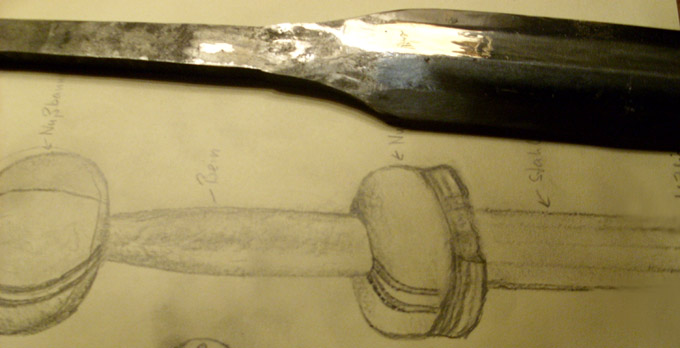
www.archaeoschmiede.de
www.eisenzeithaus.de
|
|
   |
 |
|
Peter Johnsson
Industry Professional
|
 Posted: Wed 03 Feb, 2010 12:02 am Post subject: Posted: Wed 03 Feb, 2010 12:02 am Post subject: |
 |
|
Christian,
Thanks for more pictures of that sword. One of the fine ones 
Your blade looks like one of those within the type that has less profile taper. I see nothing wrong with the shape. Some are more pointy looking, others are like your blade. If your blade is between 71 and 78 cm, it looks to fit right in wit the sub type 1 (width at the base 3.6 - 5 cm). Some of these do not have such strongly tapering blades and they go with long tangs, just like your blade.
Looking forward to see this one finished!
|
|
   |
 |
Shahril Dzulkifli

|
 Posted: Wed 03 Feb, 2010 1:58 am Post subject: Re: Germanic Iron Age Weapons Posted: Wed 03 Feb, 2010 1:58 am Post subject: Re: Germanic Iron Age Weapons |
 |
|
Christian, I think your new sword blade can be used as a model for Arminius' sword. Just design a handle like the one held by the statue and I suggest you don't have to use copper plates to create this sword. 
“You have power over your mind - not outside events. Realize this, and you will find strength”
- Marcus Aurelius
|
|
  |
 |
|
Christian Böhling
Industry Professional
|
 Posted: Wed 03 Feb, 2010 4:13 am Post subject: Posted: Wed 03 Feb, 2010 4:13 am Post subject: |
 |
|
| Peter Johnsson wrote: | Christian,
Thanks for more pictures of that sword. One of the fine ones 
Your blade looks like one of those within the type that has less profile taper. I see nothing wrong with the shape. Some are more pointy looking, others are like your blade. If your blade is between 71 and 78 cm, it looks to fit right in wit the sub type 1 (width at the base 3.6 - 5 cm). Some of these do not have such strongly tapering blades and they go with long tangs, just like your blade.
Looking forward to see this one finished! |
Thanks, Peter,
I will begin to proceed with two Swords at the weekend, this one with Illerup-fittings and scabbard like the other Illerup kit I posted, the other one with a pointy blade from the Vimose-Illerup type with fittings from Thorsberg and a scabbard from Thorsberg. Both weapons I am making by orders of customers.
Did you recognize any traces of filing or partial-grinding at the blades surface? I could not see it at this blade, as it was nearly unvisible covered with a very thin restauration-epoxy layerand the outer millimeter or a half seemed to have corroded away. I thought, the sword could also have been carefully polished by the original maker. I will try to burnish it with a "brocken" stone by hand to see if it is having the right surface after that. I cant remember to ever have seen a turning grind-stone from the roman times....I can imagine grinding with good stones must have been widely common in that times.. I am a bit afraid doing this because I don´t yet trust my skill totally...
If it is of any interest, I can post the interim results 
BTW: I look forward to see the results of the recent excavation in Illerup, Ejvind Hertz is doing there since last summer! The thousands of human bones from the middle of the first century are amazing! Maybe a whole army put into that bog. I would not be surprised if similair could be found at other bog sites. One day we will know what was going on in southern Scandinavia! I love this stuff!
www.archaeoschmiede.de
www.eisenzeithaus.de
Last edited by Christian Böhling on Tue 16 Feb, 2010 9:49 am; edited 1 time in total
|
|
   |
 |
|
Christian Böhling
Industry Professional
|
 Posted: Wed 03 Feb, 2010 4:15 am Post subject: Re: Germanic Iron Age Weapons Posted: Wed 03 Feb, 2010 4:15 am Post subject: Re: Germanic Iron Age Weapons |
 |
|
| Shahril Dzulkifli wrote: | Christian, I think your new sword blade can be used as a model for Arminius' sword. Just design a handle like the one held by the statue and I suggest you don't have to use copper plates to create this sword.  |
But Shahril,
that would be a fantasy-sword then....and that is not my interest 
www.archaeoschmiede.de
www.eisenzeithaus.de
|
|
   |
 |
Artis Aboltins

|
 Posted: Wed 03 Feb, 2010 4:17 am Post subject: Posted: Wed 03 Feb, 2010 4:17 am Post subject: |
 |
|
[quote="Christian Böhling"] | Peter Johnsson wrote: |
If it is of any interest, I can post the interim results 
|
By all means, do it! It will only enhance this already extremely informative thread.
|
|
  |
 |
|
Peter Johnsson
Industry Professional
|
 Posted: Wed 03 Feb, 2010 5:03 am Post subject: Posted: Wed 03 Feb, 2010 5:03 am Post subject: |
 |
|
On surface finish:
It is a tricky one as the surface today may have gone through several transformations.
Whenever an original is in pretty pristine condition, the surface to me looks to have been highly finished with well defined lines. No clear scratch or file marks. I imagine the final finish was achieved with stones, hand held or rotary-I don´t know. I don´t know of any roman age find of rotary grinding stones. I have not heard of any excavations showing sites of sword manufacture either.
Files were known tools, to my understanding. Stones have been used for grinding and polishing since dawn of time as has powdered polishing compound. Often the trick is to add some lubricant, like oil or fat and to find a handy way to apply the grit.
To be safe, a hand held stone seems reasonable for coarser finish. You can use a small stone in the hand, or move the sword on a stationary one.
Another possibility for finish is to use wood backed leather with fat and or oil and emery powder (can be shaped into profiles for groves and fullers). I use 600 or 800 grit and leather with oil for hand rubbing my own sword blades. It gives a smooth and satiny polish without the scoring scratch marks of emery paper.
Below an attachment as example (completely wrong time period! but you get an idea of the finish possible). This finish is completely possible with the tools and materials at hand in the iron age and was largely finished with just those methods I described above.
EDIT: perhaps more to the point, below is attached a close up of the edge of a roman sword where the original surface has been preserved between a scattering of small blisters of rust. Perhaps it is difficult to make out, but the surface gave an impression of a satiny, glossy quality. Perhaps not quite mirror finish, but smooth and without any rough scoring. You can see the original metal showing between dark patina.
EDIT2: Saying all this about the possible level of finish, I do not think swords were uniformly done to that level. As we see evidence for large scale production, but perhaps organized as multitude of cottage industries, it is reasonable that some level was the accepted norm. As with production in later times, I would expect that there were patches of rough marks showing here and there in some cases. This is just speculation. There is not that much surviving today with original surface still showing....
Grinding and filing is a natural part of sword production. At some point in work you turn from plastic forming to stock removal. This is normally done in preparation for heat treat and afterwards to get final finish and sharpness. Stones would have been natural and straight forward tools for this. How high grit was used will remain a bit speculative of course. We know that many blades were pattern welded. This demands a certain level of surface finish and possibly also etching. Based on this it is not reasonable to think that rough file marks were the accepted norm as final finish when the pattern demands a finer surface. A rough filed surface is also much more vulnerable for rusting.
 Attachment: 38.23 KB Attachment: 38.23 KB
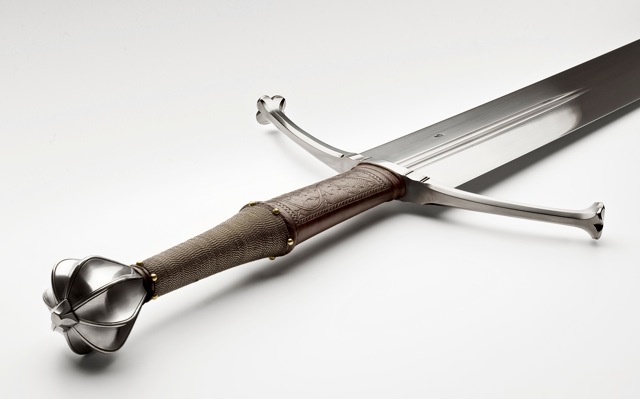
 Attachment: 98.86 KB Attachment: 98.86 KB
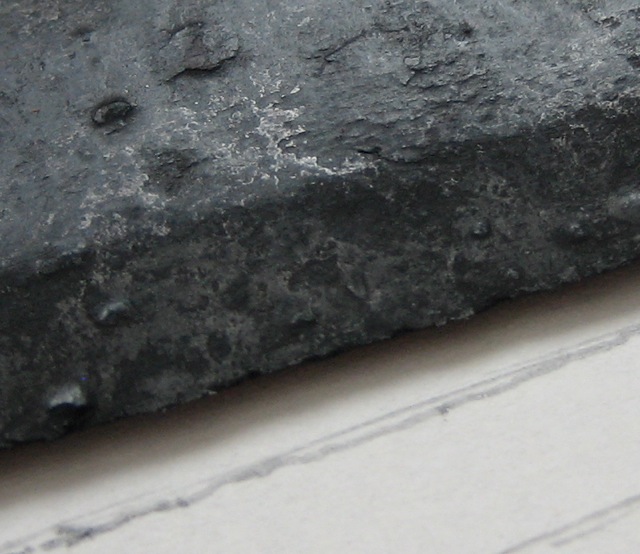
|
|
   |
 |
R D Moore

|
 Posted: Wed 03 Feb, 2010 6:39 am Post subject: Posted: Wed 03 Feb, 2010 6:39 am Post subject: |
 |
|
Christian Böhling wrote:
"If it is of any interest, I can post the interim results "
Please do! To echo Artis' comment, there are a lot of us following this discussion by you gentlemen. Thank you all!
"No man is entitled to the blessings of freedom unless he be vigilant in its preservation" ...Gen. Douglas Macarthur
|
|
   |
 |
|
Christian Böhling
Industry Professional
|
 Posted: Wed 03 Feb, 2010 6:57 am Post subject: Posted: Wed 03 Feb, 2010 6:57 am Post subject: |
 |
|
Thanks for this good insight-view in polishing and grinding methods, I hope that helps some people to see, how intensive the finishing of a good blade can be, since some people tend to think, only a forged blade is a good one, meaning, that the process of forgery is the hardest work, and finishing is easy by just going over the blade with a machine-polisher and that´s all. To me (as I just make mono-steel-blades) the finishing has always been the real main part of my work when I just count the hours I spend on this! So people who never done a sword can imagin how labor-intensive this kind of work is!
But I see there was a ittle misunderstanding in the intention of my question, probably caused by my deficient english:
My thoughts concerned on the question, how the smiths replicable produced the octagonal shape in some Vimose-Illerup blades and if the originals when observed through a microscope tells us something about the tools used for that.
I searched for traces of finishing tools but the restauration and the corrosion of the outermost surface hindered such a research or observation to me. There were some traces of files on some lanceheads we found in Kalkriese our restaurator saw clearly throgh the binocular microscope kind of "overwashed" by polishing probably with the technique you described.
It would be interesting to find out, if that, what makes us today stunning when looking at the japanese traditional finishing process, would be in some degree also to suggest for the european blade "industry".
For my Illerup blade I will try to leave out the modern machines and try by hand, but I think I will stop at a degree, when like you say, not a mirror finish is reached, but an acceptable state of a smooth surface.
BTW: I tried to form such an octagonal surface by forging - was possible (even if not perfectly done by my poor hands), but while grinding, the structure reached by forging was automatically removed again, I can´t say if it was less work then to grind compared to grind-only starting with a flat forged blade.
For this blade I started to handforge a diamant cross-section, then filed the broad side edges and after that I filed the octagonal. When I now remove the traces of filing with a stone and after it polish it, I can imagin how long it took to produce such a blade and this makes me stunning about the total number of blades found in the bog-finds!!
But I agree to you concerning the grind-cottages (in Solingen - ok a very much later industry - have been hundreds of "grind-cottages" wher people only were employed with finishing blades)
I suggest a more "indutry"-like blade production in roman times. That´s the difference to me today trying to do all from a block of steel to the finished blade, counting all the hours  calling the sword "Balmung" after that calling the sword "Balmung" after that  just kidding... just kidding...
A very fine but mass producing proto-industry.
To my opinion the understanding of the warfare either of the Germanics or the Romans has to start with the try to understand this background, utilization of resources, international devision of labor and developement of trade, time-scales for production processes and so on. And we can start with only a single blade.
Hope Petr will some day start his project and will use traditional forge welding techniques. I try it with my mono-steel (which was also common if I understood you right).
www.archaeoschmiede.de
www.eisenzeithaus.de
Last edited by Christian Böhling on Wed 03 Feb, 2010 11:56 am; edited 1 time in total
|
|
   |
 |
|
Myles Mulkey
|
 Posted: Wed 03 Feb, 2010 7:06 am Post subject: Posted: Wed 03 Feb, 2010 7:06 am Post subject: |
 |
|
| Christian Böhling wrote: | Thank you Jean!
I have done many many spear and lance heads beginning I think 10 Years ago and staring with simple iron. In the last years I make them from a high carbon steel. It was a way of self-trial and errors, before they were acourate to the originals. I forge weld the socket seams which is not an easy thing to do when the material at the end of the sockets should be as thin as the originals are. Maybe I can Post a short making of this special forge welding when I do my next lance. It is always interesting to compare different techniques of different smiths (I think we can only learn from each other). Specially the Illerup-Lanceheads are originally made from a soft center of a soft laminated iron with eges of steel of higher quality. The sockets are the continuing of the softer steel and quite easy to forge weld when there is a proper fire. I will try one in the original technique ( a collegue of mine realized a few pieces for the exhibition of the Illerup finds in the Moesgaard-Museum in Denmark showing the details in the special forge welding of those lanceheads.
BTW: Michaels spearhead looks great! It´s a fine piece of artwork!
The Illerup stuff is in any case a fascinating thing, because it shows all kinds of ironage craftmanship concentrated to one single finding site, including metalwork, bone-carving, wood-crafting, Brass-working and on and on and on. So one has to see Illerup in total. It would be interesting, to research, how many craftsmen in total and how many different types of craftmen worked for those thousands of finds there as they represent one single army defeated at once.
I add some pics to show people who never heard of Illerup before the diversity of craftmanship found at Illerup Ådal...
Below is the recreation of a comb originally found in Illerup together with ca 100 other combs. I made this piece of personal warriers equipment with outsides the bog-finds only seldom comes in appearance: |
Christian, I know this thread has progressed alot already, but would you mind going into more detail as how you made your comb? It looks like 3 different pieces: the tapered teeth piece, and two plate pieces. Is this correct? It's a similar sandwich construction to later Viking combs, but definitely has a different style.
|
|
  |
 |
|
Christian Böhling
Industry Professional
|
 Posted: Wed 03 Feb, 2010 7:26 am Post subject: Posted: Wed 03 Feb, 2010 7:26 am Post subject: |
 |
|
| Myles Mulkey wrote: |
Christian, I know this thread has progressed alot already, but would you mind going into more detail as how you made your comb? It looks like 3 different pieces: the tapered teeth piece, and two plate pieces. Is this correct? It's a similar sandwich construction to later Viking combs, but definitely has a different style. |
nearly correct, but there are more than three pieces ! The teeth-plate is made from six small and narrow plates of antler, cut in the direction of the antlers growing so that the teeth are more resistant to bending whild using the comb. These six plates were acourately planed to the exact same thickness and covered with the two grip-plates from above and below (made from the antler´s shovel), then riveted with silver wire. After that I started to saw the teeth slowely and very carefully not to brake one....It is a difficile work and takes two days!!
I search for pics of the process ....
 Attachment: 112.27 KB Attachment: 112.27 KB
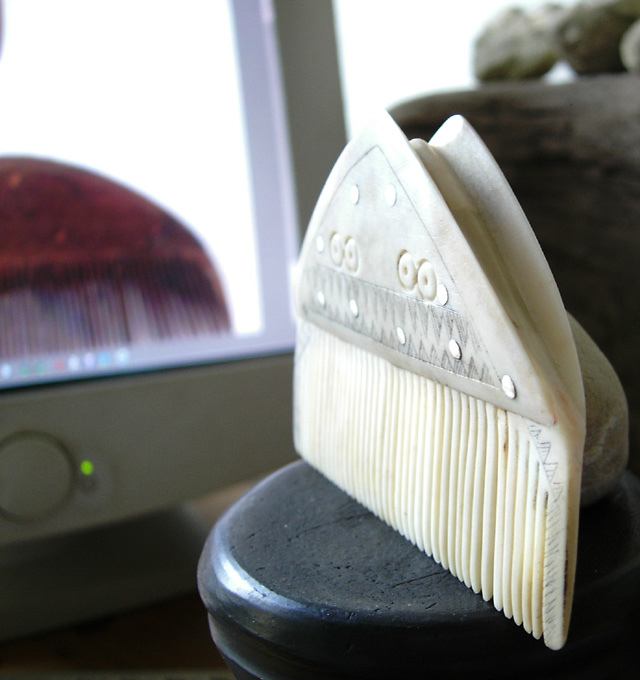
 Attachment: 104.42 KB Attachment: 104.42 KB
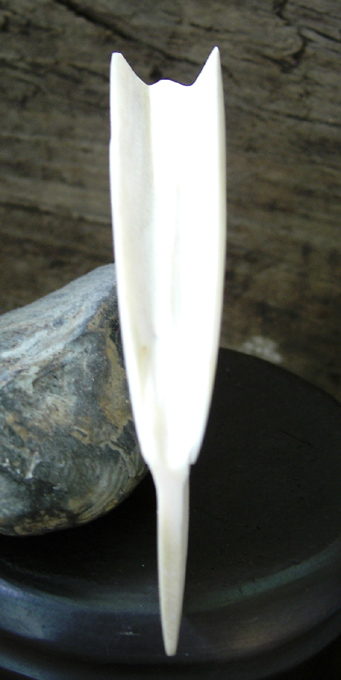
 Attachment: 83.89 KB Attachment: 83.89 KB
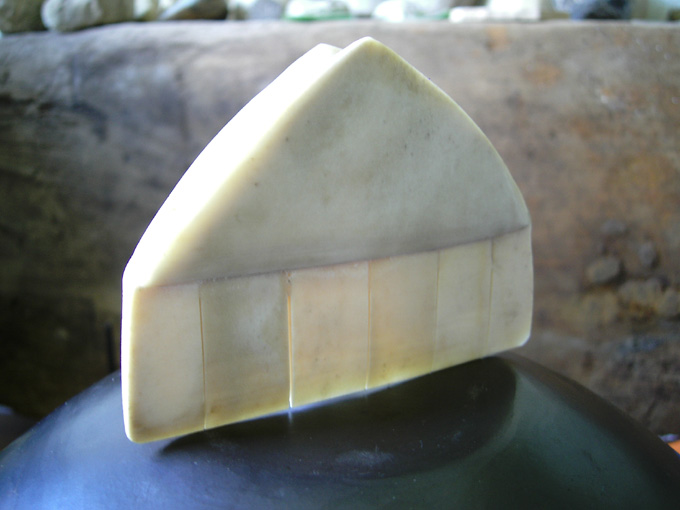
www.archaeoschmiede.de
www.eisenzeithaus.de
|
|
   |
 |
|
Christian Böhling
Industry Professional
|
 Posted: Wed 03 Feb, 2010 7:36 am Post subject: Posted: Wed 03 Feb, 2010 7:36 am Post subject: |
 |
|
| Myles Mulkey wrote: | | It's a similar sandwich construction to later Viking combs, but definitely has a different style. |
Yep! Here are some viking and medieval ones I made (comb-making is good against winter-depressions!!!! Try one yourself!!
 Attachment: 103.17 KB Attachment: 103.17 KB

 Attachment: 84.35 KB Attachment: 84.35 KB
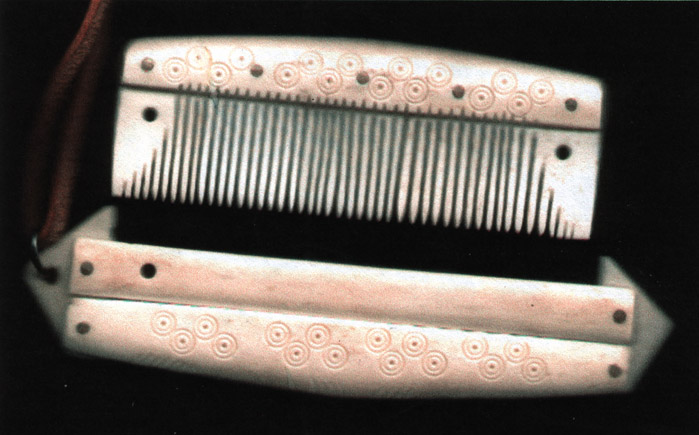
 Attachment: 101.49 KB Attachment: 101.49 KB
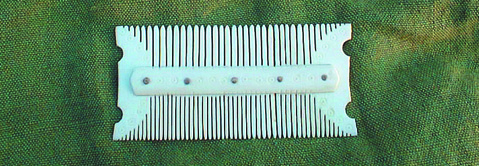
 Attachment: 90.02 KB Attachment: 90.02 KB

 Attachment: 77.65 KB Attachment: 77.65 KB
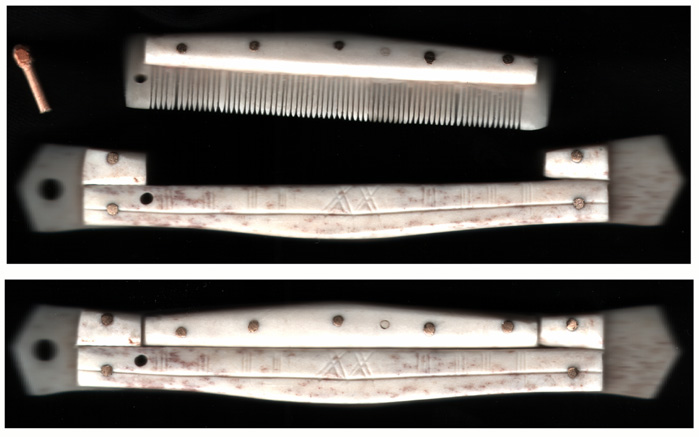
note: there are 71 teeth on only 9 cm!!!
www.archaeoschmiede.de
www.eisenzeithaus.de
|
|
   |
 |
|
Myles Mulkey
|
 Posted: Wed 03 Feb, 2010 8:04 am Post subject: Posted: Wed 03 Feb, 2010 8:04 am Post subject: |
 |
|
| Christian Böhling wrote: | | Myles Mulkey wrote: |
Christian, I know this thread has progressed alot already, but would you mind going into more detail as how you made your comb? It looks like 3 different pieces: the tapered teeth piece, and two plate pieces. Is this correct? It's a similar sandwich construction to later Viking combs, but definitely has a different style. |
nearly correct, but there are more than three pieces ! The teeth-plate is made from six small and narrow plates of antler, cut in the direction of the antlers growing so that the teeth are more resistant to bending whild using the comb. These six plates were acourately planed to the exact same thickness and covered with the two grip-plates from above and below (made from the antler´s shovel), then riveted with silver wire. After that I started to saw the teeth slowely and very carefully not to brake one....It is a difficile work and takes two days!!
I search for pics of the process .... |
Wow, these are great! I may have to try one of these...
|
|
  |
 |
Petr Florianek
Industry Professional

|
 Posted: Wed 03 Feb, 2010 8:12 am Post subject: Posted: Wed 03 Feb, 2010 8:12 am Post subject: |
 |
|
Hello! not to hijack the thread but i made little tuto on this, its in czech but pictures are selfexplanatory:
http://skjaldborg.cz/skjbook.htm
|
|
   |
 |
|
Myles Mulkey
|
 Posted: Wed 03 Feb, 2010 8:24 am Post subject: Posted: Wed 03 Feb, 2010 8:24 am Post subject: |
 |
|
| Christian Böhling wrote: | | the two grip-plates from above and below (made from the antler´s shovel) |
Are these made from elk (called moose in America, Alces alces) antlers?
|
|
  |
 |
|
Christian Böhling
Industry Professional
|
 Posted: Wed 03 Feb, 2010 9:03 am Post subject: Posted: Wed 03 Feb, 2010 9:03 am Post subject: |
 |
|
| Myles Mulkey wrote: |
Are these made from elk (called moose in America, Alces alces) antlers? |
Yes! Only the Elk has such a thick and broad material to make these big plates (exept some of the very strong red-dears here which sometimes have broad but thinner - lighter - material right under the "crown".
This is, what scandinavian archaeologists brings to the suggestion, that the combs found in Illerup with that broad and high grip-plates and the one-piece combs are of scandinavian origin, while the smaller ones assembled with more parts are denish or northern german, as Elks were not living there. Later finds from Haithabu and Birka can tell us, that antler material was traded well, so this might be a wrong conclusion. Exept this, it is without any doubt possible to take a shoulder bone from a cow for this, as there is no stress to the material here....but is is often difficult to differ if something is bone or antler, when you excavate it..
That´s what I meant when I said, that if one is looking at Illerup, one has to have a view at all kind of stuff there.
When you look at the burials in Sweden and Denmark in the same period, you can see, that only a few assorted pieces of the whole equipment can be found in graves, while the bog finds tell us how they really were equipped in total when in battle.
Compared to other and earlier times (like to the burials of the lower Elbe) it could mean, that it was the same there.
But earlier archaeologists took the inventary of a burial as the whole belongings of the buried, not as an assortment, like modern archaeologists can say...
only by the few surviving things in the few areas with weapon givings in burials the whole war-power of germanic tribes would not be explainable and the defeat of Rome were not understandable.... There is more under the surface than we know... And combs are a good beam of light into this darkness (but often overlooked in their meaning).
I write too long - I have nothing to do  There are too few guided tours here in this winter, sorry There are too few guided tours here in this winter, sorry 
www.archaeoschmiede.de
www.eisenzeithaus.de
Last edited by Christian Böhling on Wed 03 Feb, 2010 9:15 am; edited 3 times in total
|
|
   |
 |
|
Christian Böhling
Industry Professional
|
|
   |
 |
|
Dustin R. Reagan
|
 Posted: Wed 03 Feb, 2010 11:13 am Post subject: Posted: Wed 03 Feb, 2010 11:13 am Post subject: |
 |
|
| Christian Böhling wrote: | | Myles Mulkey wrote: | | It's a similar sandwich construction to later Viking combs, but definitely has a different style. |
Yep! Here are some viking and medieval ones I made (comb-making is good against winter-depressions!!!! Try one yourself!! |
Great stuff! A quick question...what sort of tool do you use to add those dot-and-concentric-ring patterns? Also, what sort of dye/filler do you use to blacken the pattern, yet not stain the rest of the piece?
Also, any tips on how to incise/engrave bone and antler? I'd like to try inlaying wire into bone, but I'm not sure the best way to incise the grooves without too much chipping? Would a standard graver set be good for this sort of thing?
Thanks,
Dustin
|
|
  |
 |
|
|
You cannot post new topics in this forum
You cannot reply to topics in this forum
You cannot edit your posts in this forum
You cannot delete your posts in this forum
You cannot vote in polls in this forum
You cannot attach files in this forum
You can download files in this forum
|
All contents © Copyright 2003-2024 myArmoury.com — All rights reserved
Discussion forums powered by phpBB © The phpBB Group
Switch to the Basic Low-bandwidth Version of the forum
|

